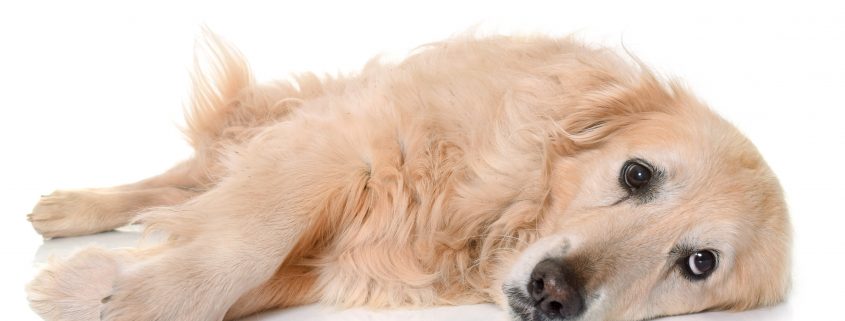By KERRI WIEDMEYER, DVM, WVRC
Bloated may be how we all feel after a nice holiday meal, but Bloat in a dog is a very different kind of bloat. Bloat, otherwise known as gastric dilatation and volvulus (GDV), is a very serious condition that occurs when the stomach fills with gas and then rotates, causing further distension and a series of severe complications.
How Do Dogs Get Bloat?
That is the million-dollar question. No one knows the exact cause of bloat; however large breed, deep-chested dogs are more likely to bloat than other breeds. Older dogs are also more commonly seen with bloat than younger dogs. In some cases, eating or drinking large amounts and then being active is thought to cause bloat. There is also thought that eating out of elevated food dishes may increase chances of bloat as dogs may swallow more air when eating.
Unfortunately, there are many times when dogs present with bloat with no predisposing cause; and, although it is much less common, small breed dogs can bloat.
What Does Bloat Look Like?
Dogs with bloat can be restless and unable to get comfortable or lay down. They will hypersalivate/drool and try to vomit, but nothing will come out. They can have very distended abdomens that can be very painful. They may also have very fast heart rates and changes in breathing. In severe cases, they may collapse or be unable to stand. It is very important that if you see any of these signs that you have your dog evaluated by a veterinarian immediately. As veterinarians, we understand that each dog can show different variations of these signs; if there is any concern, an owner can always call a veterinary clinic and ask their opinion.
Why is Bloat an Emergency?
Bloat sets off a cascade of damaging events to the body. As the stomach fills with air, it expands and starts to cut off blood returning to the heart. The expansion of the stomach then puts pressure on the diaphragm, making it difficult for the dog to breath. The stomach then starts to rotate, cutting off the blood supply to the stomach. When the stomach rotates, it can entrap the spleen and thus cause damage or cut off blood supply to the spleen and even rupture blood vessels. All of these changes lead to the dog going into shock. Blood pressure drops, arrhythmias and internal bleeding can occur as well as sepsis. Unfortunately, death can occur in a matter of hours if bloat goes undetected and untreated.
All of these changes happen very quickly, which is why it is so important for an owner to recognize the signs of bloat and get them to a veterinarian as soon as possible.
How do you Treat Bloat?
Unfortunately, there is nothing that an owner can do at home. It is imperative that the dog gets to a veterinarian as soon as possible. Typically, a radiograph will be performed to diagnose a GDV. These dogs then require pain medication, intravenous fluids and emergency surgery immediately. The surgery consists of de-rotating the stomach back to its normal position and then tacking it to the body wall. This is called a gastropexy. If the spleen was involved in the twisting, then it may have to be removed as well. Even after the surgery is performed, these dogs are not out of the woods. There are many complications that can still arise after surgery and it is very common for these dogs to be in the hospital for multiple days. As many as 15 to 30 percent of dogs will not survive bloat even with immediate care and surgery.
Preventing Bloat
Today many people are putting their minds at ease early on by getting prophylactic treatment done. If you own a large breed dog that is more likely to bloat, a gastropexy can be performed when the dog is spayed or neutered.
This procedure will not prevent the stomach from distending with gas, but it will prevent the stomach from twisting/ rotating. The “twisting” is what makes a GDV a surgical emergency. Preventing this by tacking the stomach at an early age will likely save an owner from some sleepless nights and an expensive emergency surgery.
Other considerations to try and prevent bloat are feeding several small meals a day, discouraging drinking large amounts of water at one time, allowing some time between eating and activity, and feeding on the floor.
Hopefully knowing some of these preventative tips will decrease the chances of your furry family member bloating; however, if you see the signs listed above do not wait! Get that loved one to a veterinarian.


